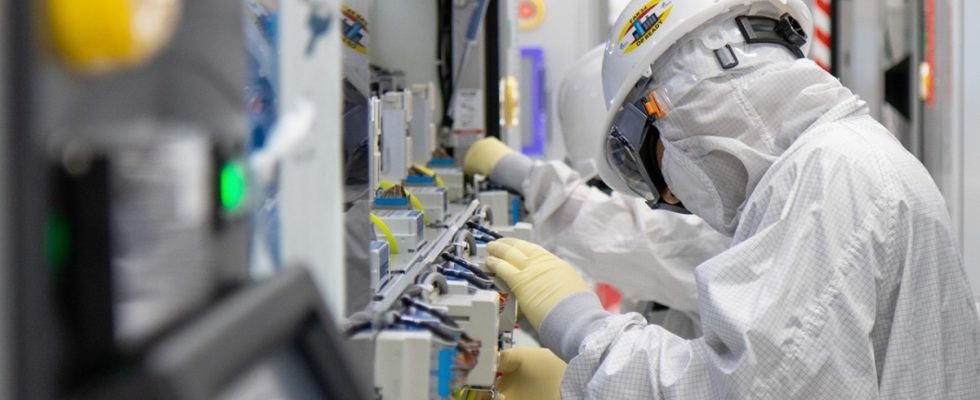You just have to let it melt in your mouth. The finest droplets of molten tin are bombarded with a laser beam in a vacuum chamber. It squeezes the droplets into a kind of flatbread. Now a second, stronger laser flash follows, which atomizes the tin cake. A plasma is created and with it what you actually want: extremely short-wave ultraviolet light. All of this happens 50,000 times per second.
And it is just one of the hundreds of work steps that are necessary to ultimately produce what drives the world today: chips. Without these highly complex manufacturing processes, it would no longer be possible to produce modern high-performance chips. Only three companies in the world can produce such chips: Samsung, TSML and Intel. The Americans call something like this “cutting edge,” cutting-edge technology. And one thing is clear: as an industrial nation, we would actually like to have something like that in our country.
It is hardly surprising when Irish Prime Minister Leo Varadkar visits the opening of just such a modern factory near Dublin at the end of September. “It’s a great day for the country,” he says, and very important for the Irish economy, both technologically and economically. Also important for Europe because the EU wants to become more independent of suppliers from Asia when it comes to key technologies. His Industry and Trade Minister Simon Coveney goes one step further: It won’t be any bigger than what Intel has invested. 17 billion euros were spent on the construction of the new “Fab” alone.
Together with investments in existing factories, Intel has invested €30 billion in production facilities in Ireland since 1989. “Figures like these remind us how important it is to have multinational companies like this here in Ireland,” says Coveney. After all, it is by far the most modern chip factory in Europe. At least until 2028. By then, Intel wants to build two new factories in Saxony-Anhalt, which will then use the latest technology.
Michael Lohan, head of the Irish Economic Development Agency, comments: The effect of Intel’s €17 billion investment will transform Ireland’s manufacturing sector. The extraordinary investment reinforces Ireland’s strategic importance in global semiconductor manufacturing.
The Irish Prime Minister warns of subsidy competition
However, the establishment of chip companies comes at a price. After all, you are not in competition with companies, but with states, argues Intel boss Pat Gelsinger. China and Taiwan, for example, have massively supported the chip industry in the past, which is why Europe and the USA’s share of production has also fallen drastically. Anyone who wants to change that would have to pay subsidies to chip manufacturers to compensate for the difference to the lower costs in Asia. The new factories in Magdeburg are worth ten billion euros.
Despite all the enthusiasm and a red-carpet approach – “Tell us what you need, we’ll take care of it,” said the Irish Prime Minister – Varadkar also warned against a subsidy competition for the establishment of new chip factories. You shouldn’t expose yourself to that. And there are also voices that claim that the Europeans, especially the Germans, have each other get blackmailed by Intel. The former EU competition commissioner Margrethe Vestager also warned against outdoing each other when it comes to subsidies.
That’s the page. The other is expressed in a few figures that Intel gave for the opening of the new factory in Ireland. Intel’s economic impact in Ireland will increase to 2.75 billion euros per year as a result of the investment. In addition to the 4,900 employees in the factories, a further 17,000 full-time positions would depend on Intel.
“A dimension I’ve never seen before”
However, the know-how that arises from such a high-tech project should not be underestimated. The best way to appreciate what this is all about is to take a tour of such a chip factory. Wearing cleanroom gear, including protective hoods and goggles, visitors stand in front of huge machines in the factory of the Dutch manufacturer ASML in Leixlip near Dublin. The exposure machine is currently open. There is a tangle of wires in the device, which is the size of a bus. But what you see in the clean room is only 20 percent, explains guide Colm Farrell. The rest is underneath, in the so-called subfab, and takes place in a vacuum.
There, the tin droplets and lasers described are used to generate extremely short-wave ultraviolet light (EUV), which is then used to expose the masks so that only partial light falls on the wafers, i.e. the discs made of high-purity silicon. Not all exposure processes take place in the EUV machines. The wafers are also etched in other machines, dry and wet, and polished – several times in a row. 15 layers of metal are applied for the latest chips. All of this, says experienced chip specialist Farrell, is “a dimension I’ve never seen before.”
A system of carts transports the wafers from machine to machine, from operation to operation. They run on rails on the ceiling of the hall and are controlled fully automatically. “Each of them costs as much as a small BMW,” says Farrell. Costs in general: A single ASML EUV exposure machine costs up to $200 million – and it takes three cargo planes to transport it. The corridor in which they stand in the new factory in Ireland is therefore rightly called Billion Alley. Operating these and the many other machines and keeping operations running as smoothly as possible requires enormous specialist knowledge. Once built up, this is also a valuable asset.

